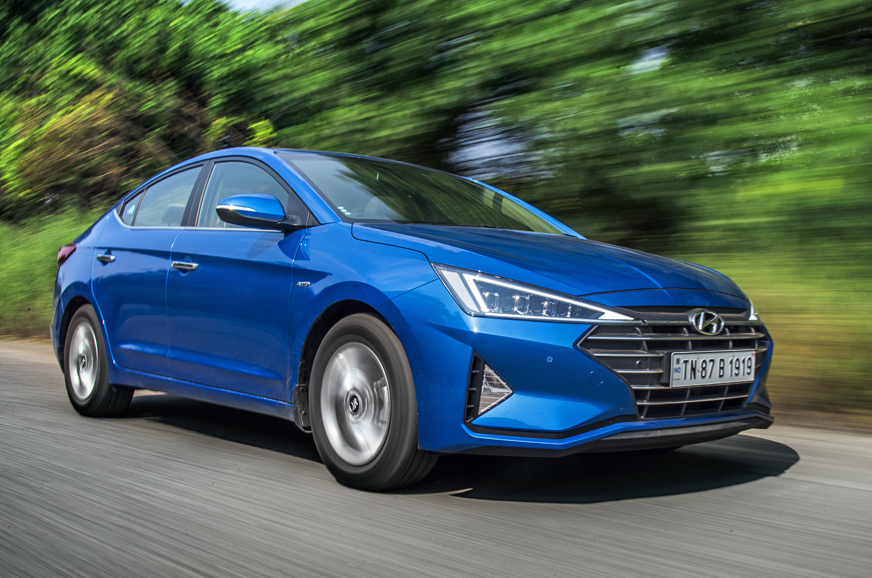
What is it?
On the face of it, it’s well, a facelift, but beyond the exterior and interior cosmetic uplift, the 6th-generation Elantra gets Hyundai's Blue Link software, making it a ‘connected car’, and the petrol engine meets the upcoming BS6 emission norms. I say petrol because, with the facelift, Hyundai has stopped the production of the diesel Elantra. The company isn’t ruling it out at a later stage, but for now, it says the Elantra will be a petrol-only model due to the low overall demand in the executive sedan segment and the skew towards petrol power. Of the 513 units sold in the February to August period, only 187 were diesels.
What’s it like on the outside?
At the front, the updated Elantra gets the brand's sharper-cut hexagonal grille but it is now punctured at the top by the sharply cut headlamps that get four projector lamp units each. LED DRLs are placed below. This sharp and angular treatment is extended to the fog lamps as well as to the bumper profile. Also revised is the bonnet that's been reskinned with a slight power bulge in the centre.
The side remains largely unchanged, with the only difference being newly designed alloys. The rear, however, like the front, gets a noticeable update. Look at the LED tail-lamps and you'll see they have a jagged lower edge with some sharp detailing to the lighting signature. Extending further into the boot lid are the lamps; this has moved the number plate down onto the reprofiled bumper. The bumper's lower edge gets some heavy black treatment mimicking an extended diffuser, thus lending it a sportier look.
What’s it like on the inside?
Hyundai has revised the Elantra's interiors as well and given it some new equipment. Most noticeable among the changes would be the new, sleeker-looking steering wheel. It doesn’t feel meaty enough in your hands though. The HVAC console is also new with three dial controls – the previous Elantra had two. What helps uplift the ambience is that some of the materials and colours have been updated and there's a nice carbon-fibre finish above the instrument panel. That said, the insides are still not the best, and Hyundai has used a lot of plastic.
In terms of equipment, a big addition on the Elantra is Hyundai's Blue Link tech, which, among other things, lets you remote-start and pre-cool your car. We tried this out a number of times and it worked in most cases. Other notable bits are a premium 8-speaker Infinity music system, wireless charging, front parking sensors and a tyre pressure monitoring system. Also, while earlier, six airbags were limited to only the top version, the Elantra facelift gets it as standard across the range. Curiously though, the auto-hold function has been deleted.
All the seats are comfortable enough, but getting into the rear requires you to step down and into the car, which could be problematic for the elderly. Like before, the top-spec Elantra has cooled front seats with the driver's seat being powered.
What’s it like to drive?
BS6-certified cars have already started rolling into our market, with most models seeing a small drop in efficiency and throttle response too. The drop in efficiency is largely due to some fuel being used for exhaust after-treatment, while the blunted performance is a result of detuning and other factors like the higher exhaust backpressure. However, what's interesting is that Hyundai has managed to get an ARAI mileage of 14.6kpl for the manual and the auto, which is identical to the BS4 cars' figure.
Making152hp and 192Nm, the BS6 Elantra's 2.0-litre engine puts out the same amount of power as the BS4 car but there is a difference in throttle feel. Where the earlier Elantra was snappy with a very responsive low end, the new car is blunted but with more linear power delivery. In terms of acceleration, the updated Elantra is slower, with our tests giving us a 0-100 time of 10.94sec – about half a second off the pace of the older car which clocked 10.46sec.
However, it isn’t all bad. The engine feels more refined now even while revving it to the 6,500rpm redline, which it will happily spin to, and you don’t have to be very conscious with your throttle inputs to avoid jackrabbit starts. The Elantra is now more driveable than before in typical daily usage.
In addition to the Normal, Eco and Sport drive modes, the engine also gets an additional Smart mode wherein it adapts to any changing driving style. It worked fine, but it kept leaning towards the Normal mode more often.
As for the rest of the drive feel, it's the same as before. The steering is numb and could have done with some more feel. And the suspension is very European in its setup – it is firm and soaks up bumps well, although body roll is noticeable.
Should I buy one?
With the facelift, Hyundai has increased the Elantra's prices, but with the variants stacked from Rs 15.89 lakh to Rs 20.39 lakh (ex-showroom), this is still the most affordable of the lot. And with the number of features on offer (some segment-unique too), it offers great value. The facelift also adds some freshness, and the updated engine, while a bit slower off the line, is more driveable and refined now. Of course, if you’re looking at owning a diesel, the Elantra is naturally out for now, and you'll have to look at the Octavia, Corolla and Civic. But if petrol power works for you, then the Elantra facelift should be high up on your list.
from Autocar India https://ift.tt/2VLSnzC
via IFTTT

No comments:
Post a Comment